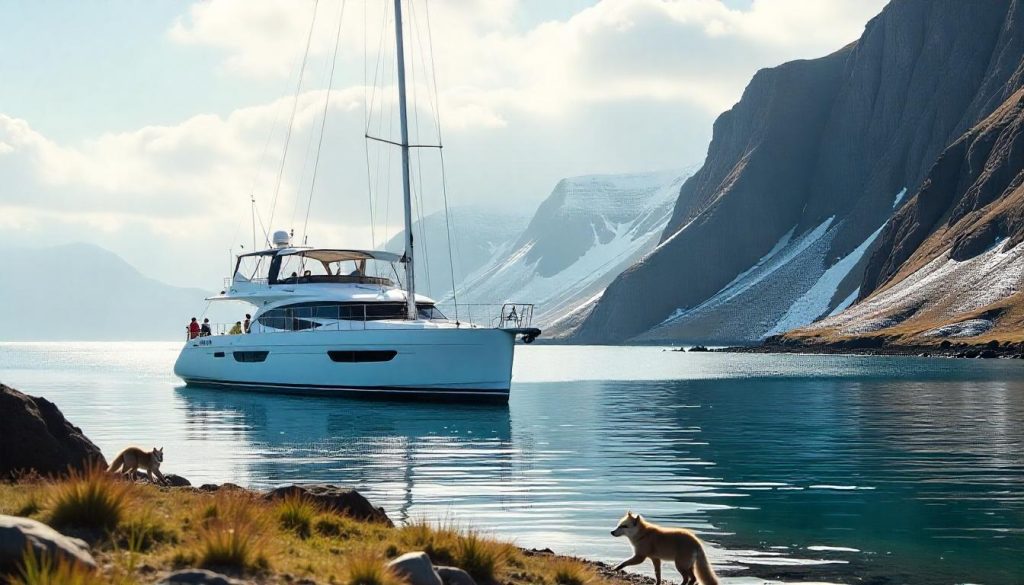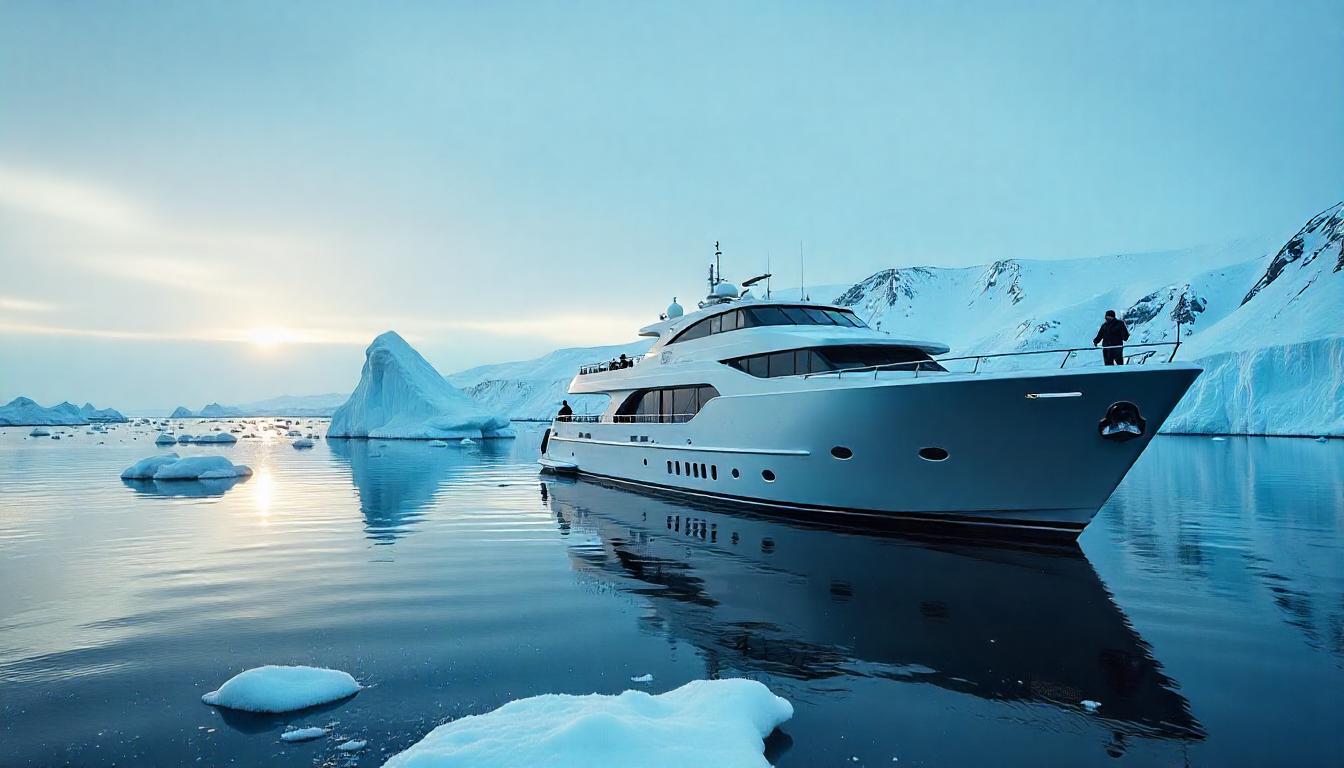Iceland, a land of fire and ice, offers a dramatic coastline that stretches over 4,970 kilometers, making Iceland coastal yachting in 2025 a breathtaking way to explore its raw beauty. From towering fjords to volcanic beaches, the island’s shores are dotted with natural wonders like puffin colonies and steaming hot springs. The waters here average 6°C in summer, per marine data, challenging yet rewarding for sailors. In this guide, we’ll navigate Iceland’s coastal gems, share top destinations, and provide practical tips for yachters. Let’s set sail to uncover the magic of Iceland’s shores.
Reykjavík: The Starting Point for Iceland Coastal Yachting
Reykjavík, Iceland’s capital, serves as the starting point for Iceland coastal yachting, offering a vibrant base with modern facilities. Begin at the Old Harbour, where Harpa Marina provides berthing for yachts up to 40 meters. For example, Harpa Marina has depths of 4-6 meters, per port data. Also, the marina offers fuel, water, and provisioning services. You can explore nearby markets like Kolaportið, where vendors sell smoked lamb for $15 per kilo, per locals. The area’s winds average 10 knots in summer, per forecasts. Thus, Reykjavík is an ideal launchpad for your Icelandic sailing adventure.
Hallgrímskirkja: A Cultural Landmark
Hallgrímskirkja, Reykjavík’s iconic church, offers a cultural landmark for yachters to explore before setting sail. A 10-minute walk from Harpa Marina leads to this basalt-inspired structure, with entry to the tower at $8, per guides. For instance, the tower provides panoramic views of Reykjavík’s colorful rooftops and Faxaflói Bay, per visitors. Also, the church’s organ, with 5,275 pipes, hosts concerts for $12, per schedules. You can grab a coffee at the nearby Café Loki for $5, enjoying local pastries, per menus. Moreover, the area’s history as a Lutheran landmark adds depth to your visit, per guides. This cultural stop makes Hallgrímskirkja a highlight. Therefore, it’s a must-see before sailing from Reykjavík.
Whale Watching in Faxaflói Bay
Faxaflói Bay, just off Reykjavík, provides a whale-watching opportunity for yachters. For example, the bay’s waters average 6°C, with visibility up to 15 meters, per reports. Also, humpback and minke whales are commonly spotted in summer, per marine guides. You can join a guided tour from the Old Harbour for $90 per person, or spot whales from your yacht, per operators. Additionally, the bay’s winds average 12 knots, requiring careful navigation, per forecasts. The sight of a whale breaching against the backdrop of Mount Esja is unforgettable, per visitors. This marine adventure makes Faxaflói Bay a standout. Thus, it’s a great start for sailors in Iceland.
Westfjords: A Rugged Coastal Escape
The Westfjords, in northwest Iceland, offer a rugged escape for sailors, with dramatic fjords and remote anchorages. Anchor near Ísafjörður, the region’s main town, in depths of 5-7 meters, suitable for yachts up to 50 meters, per charts. For instance, Ísafjörður’s marina charges $25 per night for a 40-meter yacht, per tariffs. Also, the town’s bakery sells kleina, a traditional pastry, for $3, per vendors. The waters average 5°C, per reports. The fjords’ steep cliffs rise 700 meters, creating a stunning backdrop, per geological data. Thus, the Westfjords are a top destination for adventurers.
Hornstrandir Nature Reserve: A Wilderness Haven
Hornstrandir Nature Reserve, in the northern Westfjords, offers a wilderness haven for yachters. For example, anchor near Hesteyri in depths of 4-6 meters, suitable for yachts up to 40 meters, per charts. Also, the reserve’s waters average 5°C, with visibility up to 10 meters, per reports. You can tender to shore and hike trails where Arctic foxes roam, per guides. The area has no permanent residents, ensuring solitude, per park rules. Moreover, the cliffs host puffin colonies, with over 100,000 birds in summer, per wildlife data. This untouched spot makes Hornstrandir a highlight. Therefore, it’s a must-visit for sailors seeking Iceland’s wild side.
Dynjandi Waterfall: A Coastal Spectacle
Dynjandi Waterfall, also in the Westfjords, provides a coastal spectacle for yachters. For instance, anchor in Arnarfjörður in depths of 5-7 meters, suitable for yachts up to 50 meters, per charts. Also, the waterfall, known as “Thunderous,” cascades 100 meters into the fjord, per geological data. You can tender to shore and hike a 15-minute trail to the base, with no entry fee, per guides. Additionally, the fjord’s waters average 5°C, per reports. The surrounding peaks, often snow-capped even in summer, add to the drama, per visitors. This majestic waterfall makes Dynjandi a standout. Thus, it’s a top stop for sailors in the Westfjords.
East Fjords: A Serene Sailing Route
The East Fjords, along Iceland’s eastern coast, offer a serene sailing route for Iceland coastal yachting, with tranquil waters and charming villages. Start in Seyðisfjörður, a picturesque town with a small marina. For example, Seyðisfjörður’s marina accommodates yachts up to 40 meters, with depths of 4-6 meters, per port data. Also, the town’s cafes serve fish soup for $10, a local favorite, per menus. The waters average 6°C, with visibility up to 15 meters, per reports. The fjords’ gentle slopes contrast with the Westfjords’ ruggedness, per guides. Thus, the East Fjords are perfect for a peaceful journey.
Petra’s Stone Collection: A Unique Attraction
Petra’s Stone Collection, in Stöðvarfjörður, offers a unique attraction for yachters exploring the East Fjords. A short tender ride from your anchorage leads to this museum, with entry at $12, per guides. For instance, the collection features over 10,000 minerals, including jasper and quartz, gathered by Petra Sveinsdóttir over her lifetime, per museum data. Also, the garden displays volcanic rocks, reflecting Iceland’s geology, per visitors. You can enjoy a coffee at the museum cafe for $4, per menus. Moreover, the fjord’s calm waters, averaging 6°C, make anchoring easy, per reports. This quirky stop makes Petra’s Stone Collection a highlight. Therefore, it’s a great detour for sailors in the East Fjords.
Puffin Watching in Borgarfjörður Eystri
Borgarfjörður Eystri, further north in the East Fjords, provides a puffin-watching opportunity for yachters. For example, anchor near Hafnarhólmi in depths of 4-6 meters, suitable for yachts up to 40 meters, per charts. Also, the area hosts a puffin colony of 10,000 pairs, accessible via a boardwalk with no entry fee, per guides. The waters average 6°C, with visibility up to 15 meters, per reports. You can watch puffins dive for fish, a charming sight, per locals. Additionally, the fjord’s rhyolite cliffs add vibrant colors to the landscape, per geological data. This wildlife hotspot makes Borgarfjörður Eystri a standout. Thus, it’s a must-visit for sailors in the East Fjords.

South Coast: A Dramatic Coastal Journey
Iceland’s South Coast offers a dramatic journey for Iceland coastal yachting, with black sand beaches and glacier lagoons. Anchor near Vík í Mýrdal, a small village with a basic marina. For instance, Vík’s marina accommodates yachts up to 30 meters, with depths of 3-5 meters, per port data. Also, the village’s restaurants serve lamb stew for $20, per menus. The waters average 7°C, per reports. The area’s winds can reach 15 knots, requiring careful navigation, per forecasts. Thus, the South Coast is ideal for sailors seeking dramatic landscapes.
Reynisfjara Beach: A Volcanic Wonder
Reynisfjara Beach, near Vík, offers a volcanic wonder for yachters. For example, the beach’s black sand and basalt columns create a striking contrast with the ocean, per geological data. Also, the waters average 7°C, with visibility up to 10 meters, per reports. You can tender to shore and explore the Reynisdrangar sea stacks, linked to Icelandic folklore, per guides. Additionally, the beach’s puffins nest in the cliffs, per locals. The waves, often reaching 3 meters, demand caution, per safety reports. This dramatic spot makes Reynisfjara a highlight. Therefore, it’s a top stop for sailors on the South Coast.
Jökulsárlón Glacier Lagoon: An Icy Marvel
Jökulsárlón Glacier Lagoon, further east on the South Coast, provides an icy marvel for yachters. For instance, anchor near the lagoon’s mouth in depths of 4-6 meters, suitable for yachts up to 40 meters, per charts. Also, the lagoon’s waters average 5°C, with floating icebergs, per reports. You can tender closer to see seals resting on ice, per locals. The nearby Diamond Beach, where ice chunks wash ashore, adds to the spectacle, per guides. Moreover, the lagoon’s connection to Breiðamerkurjökull glacier creates a surreal landscape, per data. This icy wonder makes Jökulsárlón a standout. Thus, it’s a must-see for sailors on the South Coast.
Practical Tips for Iceland Coastal Yachting
A successful Iceland coastal yachting trip in 2025 requires careful planning for safety and comfort. For example, the best time to sail is June to August, when daylight lasts up to 20 hours, per Icelandic climate data. Also, stock up on supplies in Reykjavík, as facilities are scarce in remote areas like the Westfjords, per guides. You should carry updated charts, as fjords like Arnarfjörður have sudden depth changes, per data. Additionally, pack insulated clothing, as temperatures can drop to 5°C even in summer, per forecasts. Thus, preparation ensures a seamless sailing experience.
Best Time to Sail Iceland
Timing your sailing trip enhances your Icelandic experience. June to August offers the best conditions, with milder temperatures averaging 10°C, per forecasts. For instance, July is ideal for visiting the East Fjords, with calmer seas, per data. However, spring and autumn bring stronger winds, averaging 20 knots, per reports. Also, the shoulder seasons make anchorages like Hesteyri quieter, per guides. The midnight sun in summer allows for extended exploration, per visitors. Therefore, summer is the best time for sailing Iceland’s coast.
Navigating Iceland’s Waters Safely
Navigating Iceland’s waters safely ensures a worry-free trip. For example, tidal currents near Jökulsárlón can be strong, requiring updated charts, per data. Also, local guides in Ísafjörður cost $80 per day, helping navigate tricky areas like Faxaflói Bay, per guidelines. You should monitor VHF channel 16 for weather updates, as fines for non-compliance can reach $200, per Icelandic law. Additionally, avoid anchoring near puffin colonies to protect wildlife, per regulations. This preparation keeps your journey smooth. Thus, navigation tools and local expertise are essential.
Conclusion: Iceland Coastal Yachting in 2025
Iceland coastal yachting in 2025 offers an unparalleled journey through a land of contrasts. Reykjavík provides a vibrant start with Harpa Marina. The Westfjords and East Fjords showcase rugged fjords and serene villages, while the South Coast dazzles with Reynisfjara Beach and Jökulsárlón Lagoon. Also, careful planning ensures a safe adventure through these icy waters. Set sail in 2025 and discover why Iceland’s coastline remains a yachter’s dream, blending dramatic nature and solitude in one extraordinary trip.


